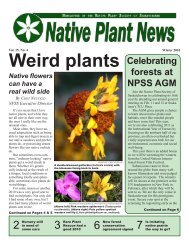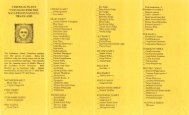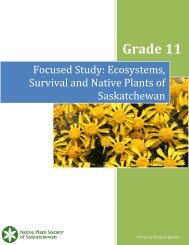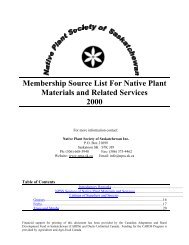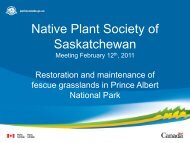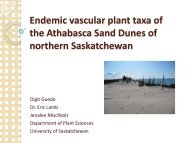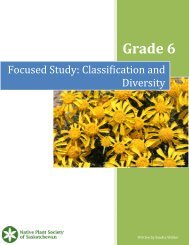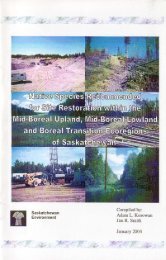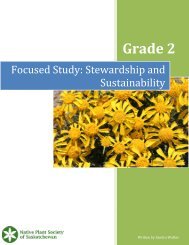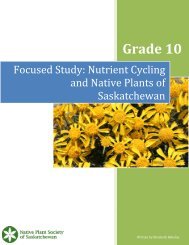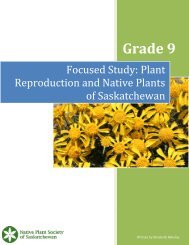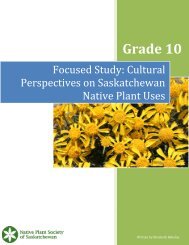Acreage Living - Native Plant Society of Saskatchewan
Acreage Living - Native Plant Society of Saskatchewan
Acreage Living - Native Plant Society of Saskatchewan
Create successful ePaper yourself
Turn your PDF publications into a flip-book with our unique Google optimized e-Paper software.
he <strong>Saskatchewan</strong><br />
f prairies had<br />
I their beginnings I6,000 years<br />
ago as the glacial ice melted. The<br />
soil types and landforms left in<br />
the wake <strong>of</strong> the glaciers, along<br />
with a harsh climate and<br />
disturbances resulting from<br />
periodic fires and grazing<br />
animals, created a unique<br />
environment. Over thousands <strong>of</strong><br />
years, the prairie landscape<br />
evolved to include a wide variety<br />
<strong>of</strong> plant and animal species<br />
particularly suited to and<br />
dependent upon, these<br />
environmental conditions. The<br />
open grassland interspersed with<br />
lakes, ponds, creeks, river valleys,<br />
shrubs and trees supported<br />
aboriginal peoples, huge herds <strong>of</strong><br />
grazinganimals and a myriad <strong>of</strong><br />
birds, insects and other wildlife.<br />
These age-old plant communities<br />
<strong>of</strong> the prairie and parkland<br />
regions <strong>of</strong> <strong>Saskatchewan</strong> are what<br />
we refer to as native prairie.<br />
Grasses dominate native<br />
prairie, but it is incredibly diverse!<br />
A close look at the prairie<br />
uncovers hundreds <strong>of</strong> different<br />
species <strong>of</strong> grasses and wildflowers.<br />
In addition to open grassland, we<br />
see wetlands, saline patches,<br />
shrubs and even forested tracts.<br />
These com mun ities contain<br />
different groups <strong>of</strong> plants, each<br />
providing a different habitat for<br />
wildlife. From early spring to late<br />
fall, the display <strong>of</strong> flowers, colours<br />
and textures in the prairie<br />
constantly changes and delights.<br />
Does your land contain native<br />
prairie? Old furrow lines or rock<br />
piles likely mean the area<br />
was cultivated in the past,<br />
but some cultivated fields<br />
may have reverted to native<br />
species if they were not<br />
cropped for long. <strong>Native</strong><br />
prairie vegetation contains<br />
many different kinds <strong>of</strong><br />
plants and you will notice a<br />
changing variety <strong>of</strong> flowers<br />
throughout the growing<br />
season. <strong>Plant</strong>s such as Needle and<br />
Thread Grass, Prairie Crocus and<br />
Western Snowberry ( Buckbrush)<br />
are good indicators <strong>of</strong> native<br />
prairie. For help with<br />
identification, use plant<br />
identification guides or consult<br />
with a local expert.<br />
Did you know that<br />
on a 4-hectare (]O-acre)<br />
parcel <strong>of</strong> native prairig<br />
you may find as many as<br />
200 different types <strong>of</strong><br />
grasset flowers and<br />
shrubs!



